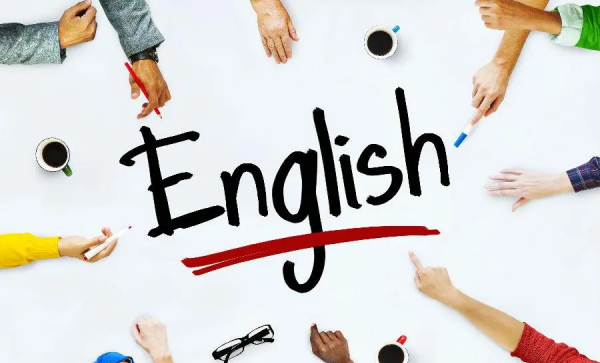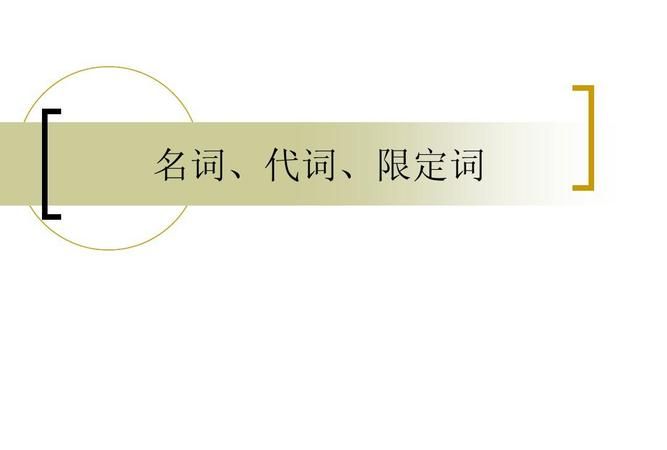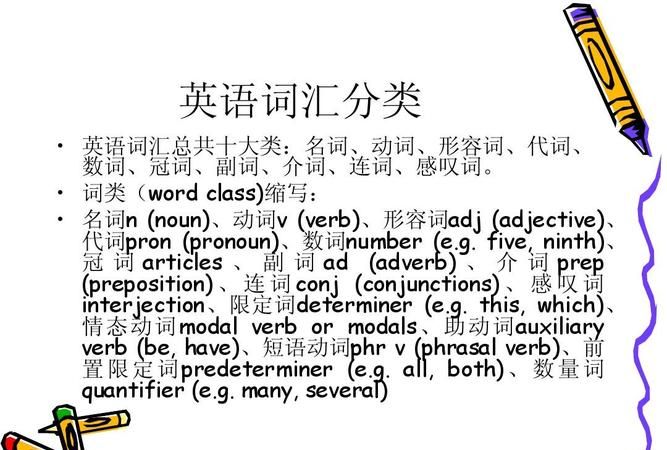本文目录
限定词有哪些
限定词包括但不限于:
(1)Articles 冠词:
冠词是一种限定词,有a, an,和the. 使用冠词的基本原则是a/an用来修饰我们第一次提到的名词。
(2)Demonstrative Pronouns 指示代词:
指示代词是this, that, these和those。这些词后面接名词时是限定词,代替名词词组时是代词。
(3)Quantifier 数量词:
当我们想要描述多少时,用数量词放在名词前。常用的数量词有many, all, no, none, lots of, a few, a number of, plenty of, any, some, a bit, much. 有些数量词只能修饰不可数名词,有些只能修饰可数名词,有些不可数和可数名词都能修饰。
(4)Possessive Adjectives 物主形容词:
当我们要描述某物属于某人或者我们正在谈论的人时,我们使用物主形容词。单一的物主形容词包括my, your, his, her, its.复数物主形容词包括our, your and their。

英语中的“限定词”介绍:
限定词是一种比较常见的词类,对应的英文名称是determiner,在字典上常被缩写为det.或DET。限定词常出现在名词词组的开头位置,用于限定所用的名词或名词词组。
然而,与传统的词性概念(如冠词、代词、形容词等)相比,限定词可以看作是另一种分类方式的产物,它不属于遵从传统分类的十大词性,却根据其自身的用法,包含有部分冠词、代词、以及形容词等。
以上内容参考:百度百科-英语语法
英语中的限定词的顺序是怎样的呢
在英语中,当名词有多个形容词修饰时,就有它们的先后顺序。下面的口诀可帮你记住这一先后顺序,也是解题的关键。
限定描绘大长高,
形状年龄和新老;
颜色国籍跟材料,
作用类别往后靠;
其中,“限定词”包括:冠词、物主代词、指示代词、或数词,它位于各类形容词前。它本身分为三位,即:前、中、后。前位限定词有all、half、both、分数和倍数;中位限定词有冠词、指示代词、物主代词等;后位限定词有基数词和序数词,但序数词位于基数词前。如:both
my
hands、all
half
his
income等。“描绘”性形容词如:beautiful、bad、cold、great等。“大长高”表示大小、长短、高低等一些词。表示“形状”的词如:round
square等。“国籍”指一个国家或地区的词。“材料”的词如:wooden,
woolen,
stone,silk等。“作用类别”的词如:medical,
college,writing
desk,police
car等

英语限量词有哪些单词
限定词(DETERMINER〕是在名词词组中对名词中心词起特指(SPECIFIC REFERENCE〕、类指(GENERIC REFERENCE〕以及表示确定数量(DEFINITE QUANTITY〕和非确定数量(INDEFINITE QUANTITY〕等限定作用的词类。名词词组除有词汇意义外,还有其所指意义(REFERENTIAL MEANING〕,是特指(即指特写的对象〕,还是类指(即泛指一类人或物〕;是有确定的数量,还是没有确定的数量。能在名词词组中表示这种所指意义的词类就是限定词。英语的限定词包括:
定冠词(DEFINTITE ARTICLE〕,不定冠词(INDEFINITE ARTICLE〕,零冠词(ZERO ARTICLE〕
物主限定词(POSSESSIVE DETERMINER〕,my, your, his, her, our, your, their, one's, its.
名词属格(GENITIVE NOUN〕,John's, my friend's.
指示限定词(DEMONSTRATIVE DETERMINER〕,this, that, these, those, such.
关系限定词(RELATIVE DETERRMINER〕,whose, which.
疑问限定词(INTERROGATIVE DETERMINER〕,what, which, whose.
不定限定词(INDEFINITE DETERMINER〕,no, some, any, each, every, enough, either, neither, all, both, half, several, many, much, (a) few, (a) little, other, another.
基数词(CARDINAL NUMERAL〕和序数词(ORDINAL NUMERAL〕
倍数词(MULTIPLICATIVE NUMERAL〕和分数词(FRACTIONAL NUMERAL〕
量词(QUANTIFIER〕a lot of, lots of, plenty of, a great of, a good deal of, a large of, a small amount of, a quantity of, a great of, a good number of等。
限定词与名词词组中心词之间有着某种固定的搭配关系;如果名词之前带有两个或两个以上的限定词,则限定词与限定词之间也有某种固定的搭配关系。本讲主要解决这两种搭配关系问题。
1 限定词与三类名词的搭配关系
限定词的选择决定于随后的名词的类别,是单数名词、复数名词,还是不可数名词。
1〕能与三类名词搭配的限定词
有些限定词如the, some, any, no, other, whose以及my, your等物主限定词和名词属格(John's, my friend's〕等能与三类名词搭配。例如:
the book, my book, my friend's book, John's book, any book, some book, no book, the other book, whose book, the books,
my books, my friend's book, John's books, any books, some books, no books, the other books, whose books, the money, my money, my friend's money, John's money, any money,
some money, no money, the other money, whose money.
2〕只能与单数名词搭配的限定词
有些限定词如a(n), one, another, each, every, either, neither, many a, such a 等只能与单数名词搭配。例如:
each worker, either book, an apple, another book, such a book, every student, neither sentence, one copy, many a book.
3) 只能与复数名词搭配的限定词
有些限定词如both, two, three, another two / three, many, (a) few, several, these, those, a (great) number of等只能与复数名词搭配。例如:
both workers, several students, a number of essays, many students, (a) few words, these / those books, two / three visitors, another two / three students.
4) 只能与不可数名词搭配的限定词
有些限定词如a (little) bit of, a great amount of, a great deal of, (a) little, much等只能与不可数名词搭配。例如:
a bit of water, a great amount of labour, a great deal of work, (a) little space, much noise.
5〕能与单、复数名词搭配的限定词
有些限定词如the first, the second, the last, the next等既可与单数名词搭配,也可与复数名词搭配。例如:
the first rose, the last man, the next meeting, the first roses, the last men, the next meetings.
6〕能与单数名词和不可数名词搭配的限定词
有些限定词如this, that, (the) least等能与单数名词和不可数名词搭配。例如:
(the) least sign (of prejudice), this / that job, (the) least knowledge, this / that work.
7〕能与复数名词和不可数名词搭配的限定词
还有些限定词如a lot of, lots of, enough, more, most, such, other等可与复数名词和不可数名词搭配。例如:
a lot of books, a lot of money, lots of chickens, lots of food, plenty of chairs, plenty of water, enough copies, enough coal, more articles, more time, most people, most work, such men, such bread, other men, other bread.
不定量限定词less原先只与不可数名词搭配,但在现代英语中,less既可与不可数名词也可与复数名词搭配。例如:
less money, less mistakes.
2 限定词与限定词的搭配关系
以上讲的是限定词与三类名词的搭配关系。除上述搭配关系外,限定词与限定词之间还存在着一定的搭配关系。在名词词组中心词之前如果有两个或两个以上限定词出现时,就会产生限定词的先后顺序问题。按其不同的搭配位置,限定词可分为:
1〕中位、前位、后位限定词
按照限定词与限定词之间不同搭配位置,限定词可分为中位限定词(CENTRAL DETERMINER〕、前位限定词(PREDETERMINER〕和后位限定词(POSTDETERMINER〕。
a) 中位限定词包括a(n), the, zero; this, that, these, those; my, your, etc; Merry's, my friend's; some, any, no, every, each, either, neither, enough; what(ever), which(ever), whose等
b) 前位限定词包括all, both, half; double, twice, three times, etc; one-third, two-fifths, etc; what, such, (a / an)等
c) 后位限定词包括one, two, three, etc; first, second, third, etc; next, last, other, another, etc; many, much, (a) few, (a) little, fewer, (the) fewest, less, (the) least, more, most; several, plenty of, a lot of, lots of, a great / large / good number of, a great / good deal of, a large / small amount of; such等

常见的限定词有哪些
限定词如下:
1、this:英语单词,发音:[英][ðɪs][美][ðɪs]。常翻译为:这,这么。
2、whose:英语单词,主要用作代词,代词时意为“谁的(疑问代词)”。
3、such:英文单词,形容词、名词,作形容词时意为“这样的,如此的”,作名词时意为“人名;(英)萨奇;(德)祖赫”。

4、what:什么;多么;多少;到什么程度,在哪一方面。
5、these:英文单词,主要用作限定词、代词、形容词,作限定词时意为“这些”,作代词时意为“这些”,作形容词时意为“这些”。
以上就是关于英语限定词有哪些,限定词有哪些的全部内容,以及英语限定词有哪些 的相关内容,希望能够帮到您。

